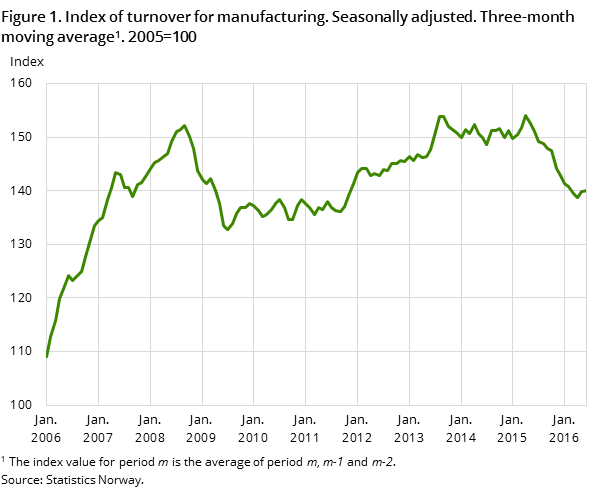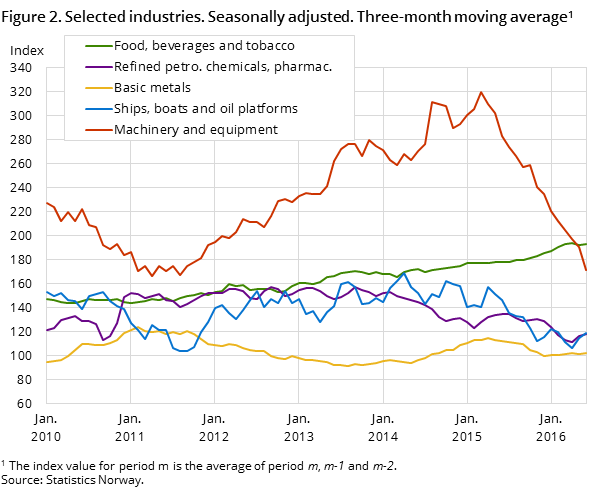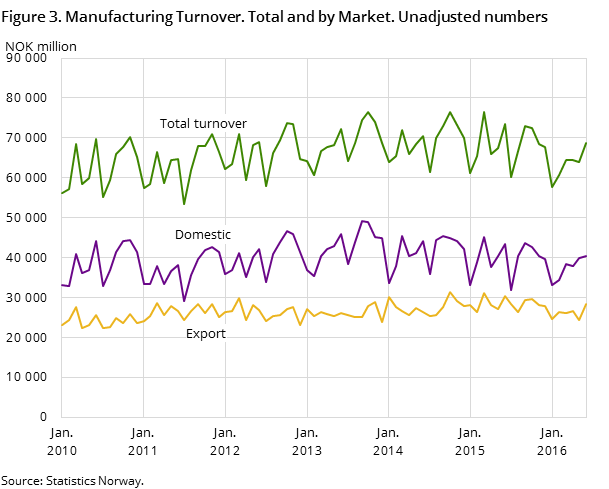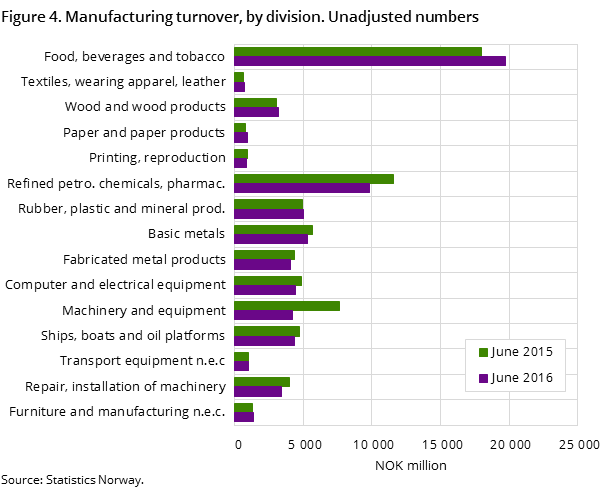Content
Published:
This is an archived release.
As from 23 September, all of Statistics Norway’s statistics will be released at 8am.
Still no change in manufacturing turnover
Seasonally-adjusted figures showed that the total turnover in Norwegian manufacturing increased by 0.4 per cent from the first to the second quarter of 2016. However, a 1.1 per cent fall was recorded from May to June 2016.
| Seasonally adjusted | Calendar adjusted1 | Unadjusted | ||
|---|---|---|---|---|
| Monthly change | Three-month change | Twelve-month change | NOK million | |
| June 2016 / May 2016 | April 2016 - June 2016 / January 2016 - March 2016 | June 2016 / June 2015 | June 2016 | |
| 1Adjusted for working-days and for public holidays in Norway. | ||||
| Extraction, mining, manufacturing and elec | 0.9 | 2.4 | -14.0 | 116 230 |
| Extraction and related services | 0.2 | 5.6 | -30.9 | 36 573 |
| Mining and quarrying | 5.6 | 11.6 | -16.2 | 1 036 |
| Manufacturing | -1.1 | 0.4 | -6.7 | 68 620 |
| Food, beverages and tobacco | 0.5 | 0.1 | 9.4 | 19 711 |
| Refined petro., chemicals, pharmac. | -1.0 | 4.4 | -14.9 | 9 844 |
| Basic metals | 5.1 | 0.8 | -5.4 | 5 340 |
| Machinery and equipment | -13.0 | -16.3 | -44.7 | 4 224 |
| Ships, boats and oil platforms | -6.5 | 6.5 | -5.6 | 4 341 |
| Electricity, gas and steam | 15.5 | 2.8 | 41.9 | 10 000 |




The index value for turnover in manufacturing was 140.1 (2005=100) in the second quarter of 2016, compared to 139.5 in the previous quarter, according to seasonally-adjusted figures.
Three-month change: growth for refined petroleum, chemical and pharmaceutical industries
Seasonally-adjusted figures showed that the grouping refined petroleum, chemical and pharmaceutical industries edged up 4.4 per cent from the first to the second quarter of 2016. Moreover, several large deliveries of built ships in April and May led to solid growth in building of ships, boats and oil platforms industry.
The biggest contributor pulling down total manufacturing turnover was machinery and equipment, which recorded a decrease of 16 per cent.
Monthly change: fall for suppliers to the oil and gas sector industries
Total Norwegian manufacturing turnover went down 1.1 per cent from May to June 2016, according to seasonally-adjusted figures.
Machinery and equipment as well as building of ships, boats and oil platforms industry had a decrease in turnover, with 13 and 6.5 per cent respectively. Basic chemical products, and computer and electrical equipment also recorded a reduction in turnover.
On the other hand, turnover in repair, installation of machinery, basic metal, and fabricated metal products showed a growth. Food products accounted for about 27 per cent of total manufacturing turnover, rising 1.8 per cent in this period.
Twelve-month change: continued strong downturn in machinery and equipment
Calendar-adjusted figures showed that the total turnover went down 6.7 per cent from June 2016 compared to June 2015. Both the home and export market faced a decline of 6.9 and 6.5 per cent respectively.
Machinery and equipment recorded the strongest negative trend (45 per cent) from June 2015, while food products with a 9.4 per cent growth helped to curb the reduction in total turnover.
Monthly change: growth in Norway, slight fall in the euro area in May 2016
Norwegian manufacturing turnover went up 2.0 per cent from April to May 2016 according to seasonally-adjusted figures. Manufacturing turnover in the euro area faced a slight decrease of 0.3 per cent. In the Nordic countries, Sweden and Denmark showed a decrease of 4.0 and 1.0 per cent respectively, according to Eurostat.
Find more figures
Find detailed figures from Turnover in oil and gas, manufacturing, mining and electricity supply
Additional information
The variation in manufacturing turnover can be related to changes in volume and price indices in different industries and also production to stocks and sales from stocks.
Contact
-
Robert Skotvold
E-mail: robert.skotvold@ssb.no
tel.: (+47) 40 90 24 44
-
Anne Karin Linderud Haugen
E-mail: anne.karin.linderud.haugen@ssb.no
tel.: (+47) 91 88 19 76
